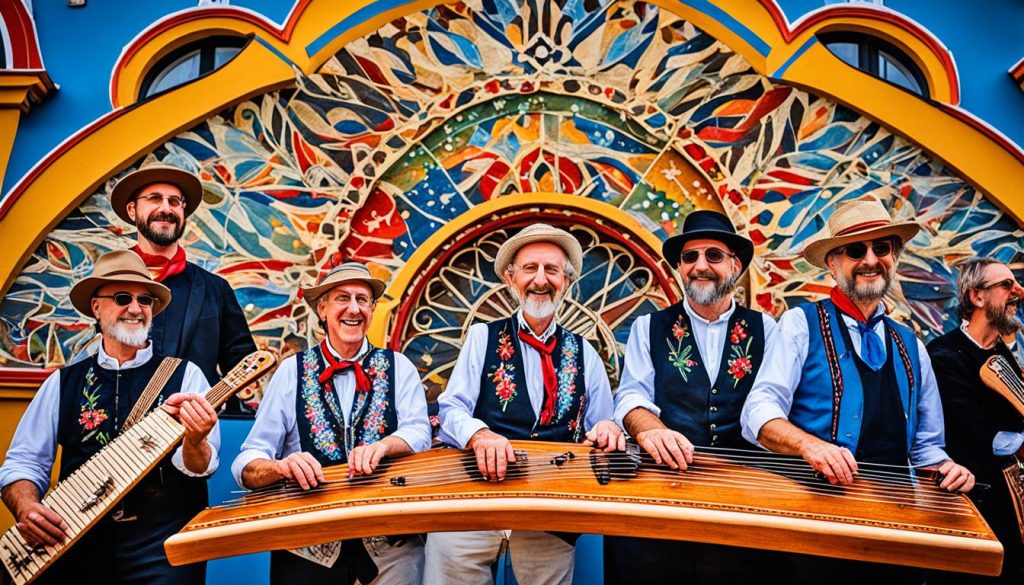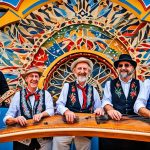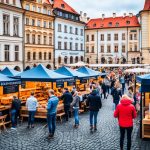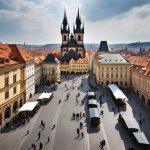The Czech Republic is known for its rich cultural legacy. It beautifully mixes music and art. Famous for classical music, folk tunes, and detailed art, the country’s culture is both varied and important historically.
The legends of Antonín Dvořák and the art of Alfons Mucha show Czech traditions’ worldwide influence. These masterpieces highlight the nation’s global cultural contributions.
Through the ages, from medieval times to the Renaissance and Baroque eras, Czech music and art have grown. They show the country’s ability to overcome challenges and innovate. Festivals and art shows in the Czech Republic are a tribute to its ongoing cultural excellence.
Key Takeaways
- The Czech Republic integrates music and art within its rich cultural heritage.
- Esteemed composers and artists like Antonín Dvořák and Alfons Mucha have significantly influenced global culture.
- The evolution of music and art in the Czech Republic spans from medieval times to the contemporary era.
- Folk traditions play a pivotal role in shaping Czech cultural identity.
- Numerous festivals and exhibitions highlight the nation’s dedication to celebrating its cultural patrimony.
Historical Evolution of Czech Music and Art
Czech art history and music have a rich background, showing cultural growth through time. Each era left a lasting impact on the Czech Republic’s artistic and musical styles.
Medieval Beginnings
The Medieval era set the stage for Czech music with liturgical chants and religious works playing a big role. Art from this time, seen in manuscripts and buildings, showcased religious themes.
Renaissance Influence
The Czech Renaissance was a time of growth, where music and art were influenced by humanist ideas. Music became more complex, with rich polyphonic textures. Art celebrated humanity and ancient myths.
Baroque and Classical Periods
The Baroque period brought more emotional depth and complex decoration to Czech music. Composers like Jan Dismas Zelenka added to the national music style with their work. The era’s art and architecture were ornate, adding to the Czech Republic’s rich cultural heritage.
The Role of Folk Traditions in Czech Culture
Czech folklore is at the heart of the country’s culture. It has been passed down through the ages. It shows the history, beliefs, and creativity of the Czech people.
Folklore and Folk Music
Folk music is key to Czech heritage. Its emotional tunes and meaningful words tell the story of Czech life. Music is played on traditional instruments like the violin and bagpipes. This makes Czech folk music vital for national festivities. These songs bring people together, celebrating Czech folklore through music and dance.
Traditional Art Forms
Traditional Czech art shows the country’s commitment to its heritage. Things like costume embroidery and glass painting show Czech artistry. These folk arts highlight the talents of Czech craftspeople. They’re shown off at cultural events and exhibitions. This underlines their importance in sharing Czech identity and history.
Iconic Czech Composers and Their Contributions
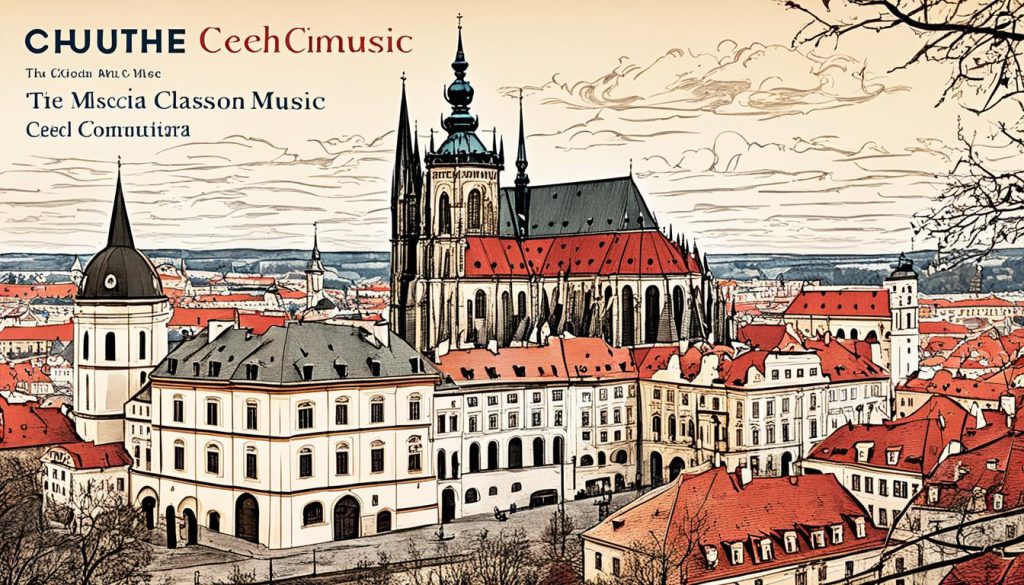
The Czech Republic shines in classical music, thanks to key composers. Antonín Dvořák, Bedřich Smetana, and Leoš Janáček are particularly noteworthy. They have left a lasting impact on music worldwide.
Antonín Dvořák is a major composer in Czech music, famous for his New World Symphony. His music mixes Czech culture with classical music. This makes his work beloved inside and outside Czech Republic.
Bedřich Smetana is known as the father of Czech music. His work, like the “Má vlast” symphonic poems, celebrates the Czech lands. These pieces share the stories and beauty of Czech history and landscapes.
Leoš Janáček brings Czech folk tales to life in his music. His operas and chamber pieces use Moravian folk tunes. His unique style makes Czech music rich and varied.
| Composer | Notable Works | Contribution |
|---|---|---|
| Antonín Dvořák | New World Symphony, Slavonic Dances | Infusion of Czech nationalistic elements into classical forms |
| Bedřich Smetana | Má vlast, The Bartered Bride | Reflecting Czech heritage through operas and symphonic poems |
| Leoš Janáček | Jenůfa, Sinfonietta | Integration of Moranian folk melodies and speech rhythms |
Traditional Czech Instruments and Their Significance
The Czech Republic is rich in culture, shown in its traditional music. Its unique musical instruments are key symbols of this culture. They highlight the musical past and show the country’s strong traditions.
Bagpipes and Fiddles
Bagpipes and fiddles are iconic Czech musical instruments. Bagpipes, loved in Bohemia, are central to Czech folk music. Fiddles bring joy and are crucial for traditional Czech parties and celebrations.
Hurdy-Gurdy and Dulcimer
The hurdy-gurdy and dulcimer are also important. The hurdy-gurdy adds a unique sound, important for medieval and street music in the Czech Republic. The dulcimer, vital in Moravian folk music, adds lovely tones to groups.
These instruments are more than just for music. They’re celebrated in festivals and kept in museums. They keep Czech music traditions alive for the future.
The Czech Republic’s Culture is Great for Music and Art
The Czech Republic is known for its rich cultural heritage. This makes it a perfect place for music and art to thrive. There are many cultural institutions, celebrations, and programmes aimed at growing talent. Such initiatives invite both visitors and locals to enjoy performances in historic spots, lively street art, and traditional music that fills both cities and the countryside. Indeed, music and art hold a special place in the heart of Czech society.
The country’s cultural heritage shines through its art galleries, museums, and theatres. These venues celebrate Czech arts every year. Prominent events include the Prague Spring International Music Festival and Colours of Ostrava. They highlight traditional and modern artworks, showing the lively culture of the Czech Republic.
Education also plays a key role in keeping the Czech Republic’s cultural heritage alive. The Academy of Performing Arts in Prague, for instance, helps nurture upcoming artists and musicians. Such dedication ensures the nation’s artistic traditions are preserved while also embracing new and inventive forms of expression.
The celebration of arts is a core aspect of life in the Czech Republic. It’s clear in the careful keeping of folk traditions and the innovation seen in urban art. The Czech Republic demonstrates how culture can bring people together and spark inspiration.
| Aspect | Highlight |
|---|---|
| Historic Venues | Esteemed venues like Rudolfinum and Municipal House |
| Vibrant Street Art | Dynamic expressions in urban centres |
| Folk Traditions | Preservation of melodic and artistic folk traditions |
| Educational Institutions | Academy of Performing Arts in Prague |
Influence of Czech Nationalism on Music and Art

National pride greatly influenced Czech music and art in the eighteenth and nineteenth centuries. Creators used their national heritage as a source of inspiration. During the nineteenth century, a new wave of national consciousness emerged. Artists and composers filled their works with patriotic themes.
Bedřich Smetana was key in this movement. His compositions brought the Czech landscape and myths to life. One of his major works, “Má vlast” (My Homeland), is a celebration of the Czech nation. It uses music to paint scenes of Bohemia’s beauty and history’s heroes. Smetana’s work still touches hearts with its national pride.
In visual arts, artists explored Czech history, symbols, and folklore. Such works aimed to strengthen cultural identity. Through paintings and sculptures, they conveyed powerful messages of unity and pride.
This movement also touched theatre, literature, and other cultural areas, spreading a patriotic spirit. Today, Czech art and music remain essential for understanding the nation’s heritage. They continue to inspire pride in the Czech Republic’s cultural achievements.
- Bedřich Smetana: His composition “Má vlast” (My Homeland) continues to be a foundational piece in patriotic Czech quiet.
- Alfons Mucha: A major name in Art Nouveau, Mucha’s artwork often highlighted nationalistic themes.
Czech Opera: A Blend of Drama and Music
Czech opera ties deeply with the nation’s culture, presenting drama and music together. This blend has won hearts globally, making it a beloved cultural symbol.
Origins and Development
Czech opera started with local folk traditions. Its early works drew from these cultural roots, evolving into grand performances. Prestigious Czech opera houses hosted these, merging dramatic tales with powerful music.
Famous Czech Operas
Many famous operas come from Czech stages. Among them, Bedřich Smetana’s “The Bartered Bride” and Leoš Janáček’s “Jenůfa” stand out. Their emotional richness and complex music have captivated audiences worldwide, enhancing Czech opera’s reputation.
The Influence of Czech Art Nouveau Movement
The Art Nouveau movement has deeply influenced Czech art and architecture, blending beauty with daily life. Alfons Mucha, a central figure, embodies Czech Art Nouveau through his iconic works.
Alfons Mucha and the Art Nouveau
Alfons Mucha’s art is known for its beautiful linear designs and mesmerising figures. He masterfully used flowing lines and natural shapes, creating a unique style. His works capture the essence of Art Nouveau, combining nature, beauty, and symbols seamlessly.
Architectural Impact
Czech Art Nouveau’s influence was not limited to just paintings; it transformed architecture as well. Buildings in the Czech Republic showcase natural curves and forms. This has decorated cities like Prague with harmonious and eye-catching landscapes.
This movement didn’t just alter Czech visuals but left a lasting mark for future generations to admire and explore.
Impact of Political Changes on Czech Music and Art
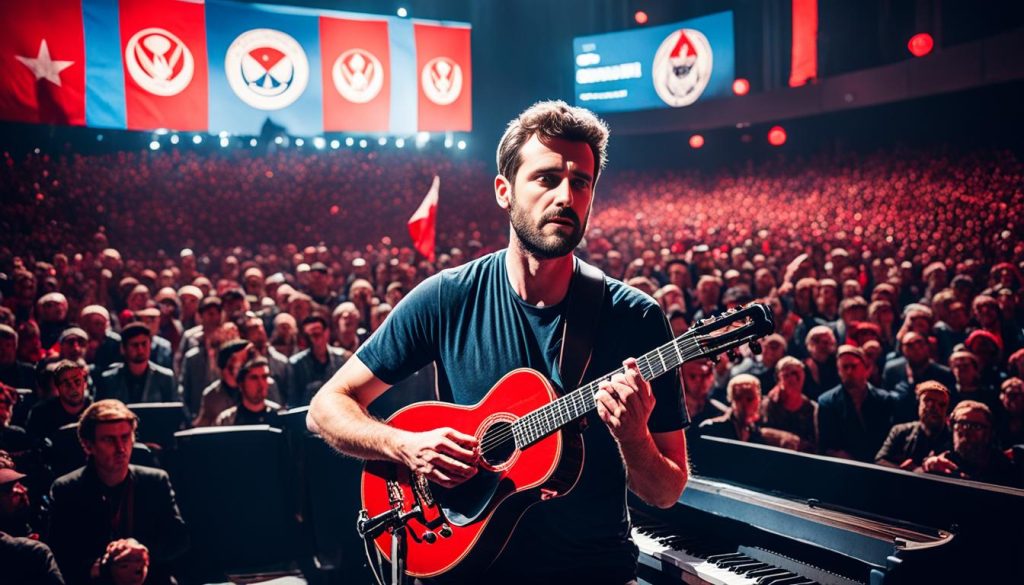
The Czech Republic’s political changes deeply altered its music and art. The Communist era limited how artists could express themselves. These restrictions shaped the nation’s cultural outputs significantly.
Communist Era Restrictions
Communism brought strict oversight to Czech art and music. Every aspect faced censorship to match state ideology. Yet, many artists and musicians cleverly bypassed these limits. They fueled an underground scene with their hidden talents.
| Political Era | Influence on Art | Artist Strategies |
|---|---|---|
| Communist Era | Strict Censorship | Underground Networks |
| Post-Communist Revival | Creative Freedom | Artistic Diversity |
Post-Communist Revival
After the Velvet Revolution, art and music in Czech saw major freedom. The shift in politics led to a cultural renaissance. Artists and musicians were now free to explore and innovate. This openness birthed a rich, diverse cultural scene, showcasing the country’s renewed spirit.
Czech Music Festivals: Celebrating Culture
Music festivals in the Czech Republic are big cultural events. They attract locals and tourists with their lively atmospheres and varied performers. The Prague music scene is especially important, marking a key spot in the country’s cultural year.
Prague Spring International Music Festival
The Prague Spring International Music Festival is a top event for classical music. It attracts famous artists and orchestras from across the world. Every spring, Prague’s music scene shines, offering stunning performances that showcase the city’s rich musical past.
Colours of Ostrava
The Colours of Ostraja festival, however, provides a more varied and modern vibe. It happens in the centre of Ostrava. Here, international artists play a mix of genres, from rock and pop to electronic and world music. It’s not just entertaining but also promotes cultural exchange, highlighting the lively nature of Czech music festivals.
Famous Czech Art Galleries and Museums
The Czech Republic is full of art galleries and museums. They hold collections that tell the artistic history of the country. Famous places like the National Gallery in Prague show art from the Middle Ages to today. Smaller galleries focus on the works of specific artists. These places are key to keeping the country’s art safe and available for everyone to enjoy.
The Kampa Museum is a standout for its modern art in the Czech Republic. It presents Czech art collections in a way that makes people admire and think. Meanwhile, the Moravian Gallery in Brno shows the country’s artistic variety, with works from Gothic period to the modern age.
Gallery shows are designed to attract regular people and art experts alike. The Trade Fair Palace has modern and contemporary art in a new style setting. The Museum of Decorative Arts in Prague showcases art that’s also useful, with pieces from across centuries.
Czech art collections play a big role in making people appreciate the country’s cultural gifts. Places like the DOX Centre for Contemporary Art in Prague push visitors to think with their unique shows and multimedia. These places are not just for storing art, but also for sparking cultural talks and new ideas.
To sum up, museums and gallery shows in the Czech Republic highlight its commitment to art. They offer a look into Czech art’s past and present, showing everything from classic pieces to modern innovations. These institutions are like doors to the world of Czech artistry, showing its beauty and changes over time.
Theatre and Performing Arts in Czech Culture
Czech culture shines through its theatre tradition. Prague is key here, with its historic theatres playing a major role. These venues blend old charm with new innovation. This mix delights audiences, keeping the Czech Republic at the forefront of global performing arts.
Historical Theatres in Prague
Prague’s historic theatres are central to the Czech theatre tradition. The National Theatre showcases Czech artistry and architecture. It’s famous for lavish design and cultural significance. Here, audiences enjoy classical to modern shows. The Estates Theatre is another gem. It’s among Europe’s oldest theatres and premiered Mozart’s “Don Giovanni”. Its contribution to Prague’s arts scene is immense.
Modern Theatrical Innovations
The Czech Republic is a leader in modern theatre. It brings fresh ideas from the National Theatre to smaller venues. Prague’s art scene is diverse, blending innovative stories with new technologies. This leads to striking performances that captivate today’s audiences. The Czech tradition of theatre continues to evolve and inspire.

